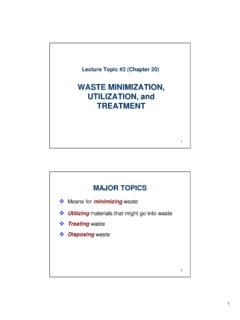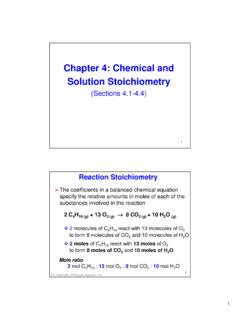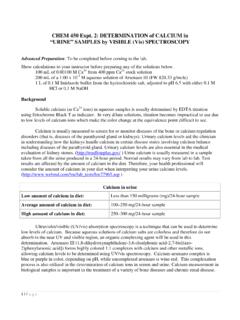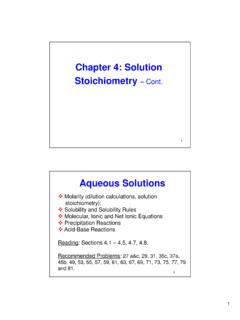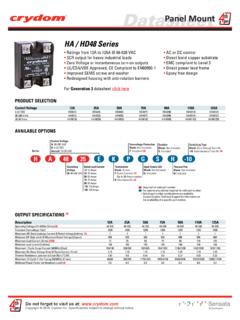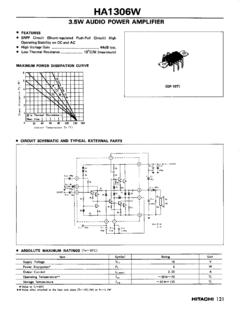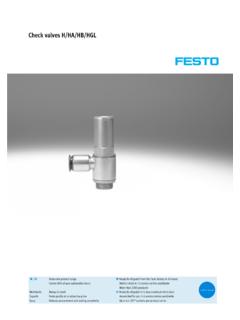Transcription of Lec7 Ch11 AcidBase Titn - Bridgewater State University
1 1 Chapter 10 ACID-BASE TITRATIONS1 Strong Acid-Strong Base TitrationsAbbreviationsExample:A mL solution of M NaOH is titrated with M HCl. Calculate the pH of solution at the following volumes of HCl added: 0, , Ve, and ++ OH-H2 OVa= volume of strong acid, volume of strong base, vol. titrant acid or base needed to reach the equivalence pointNet ionic equation:What is K for this reaction at 25 0C?K = 1/Kw Very large K; reaction goes to Titrations(Cont.)WORK:First you must determine VeSince the reaction stoichiometry is 1:1, mol H+= mol OH-At the equiv. ,Max Va= Mbx VbSince HCl is the titrant we substitute Vefor Va:Max Ve= Mbx VbAt the equiv.
2 VbMaSubstituting the given quantities we get:Ve= {( mL)( M)} MVe= Titrations(Cont.)Calculate the solution pH at different Va sRegion 1: Before the equivalence point(WhenVa< Ve)(a) pH when Va= 0 What species is in solution? There is unreacted NaOH in solution, so the pH is still basic Amount of excess NaOH determines pH Only M NaOH is solution,pOH = - log ( M) = = Va= 043 Region 1: Before the equiv. pt.(Cont.)(b) pH when Va= mL Since Ve= mL, we know that Va= mL is only 20 % of Ve Thus, 80 % of NaOH remains unreacted But wait, the total volume of has been changed by addition of titrant! Titrations(Cont.)
3 5 WORK Cont.(b) pH when Va= mL Use changes in # moles OH-during titration with H+ to calc. pH [OH-] =Initial mol OH-- mol OH-reactedVtot[OH-] =[( M)( mL)] - ( M)( mL)pH = Va= mL= mol H+added= mol H+ mL[OH-] = x Titrations(Cont.) Titrations(Cont.)Calculate the solution pH at different Va sRegion 2: At the equivalence point(WhenVa= Ve)What species is in solution? Equimolar amounts of HCl and NaOH have reacted to form NaCland H2O NaCl is made of spectator ions, => gives neutral pH in solutionThus, pH = the equivalence Titrations(Cont.)Region 3: Beyond the equivalence point(WhenVa> Ve)What species is in solution?
4 Excess titrant, H+, determines solution pHpH when Va= mL mL of H+is in excess of Ve Do not ignore dilutionVa- VeVtot[H+]x s= Maxvol. in x s of Ve= ( M) mL ( + ) mL [H+]x s= x 10-4M; pH = Va> Titrations(Cont.)Alternative work: Construct an I-C-F table (F = final). Remember that titration reactions go to completion so there is no equilibrium (E).Example:A mL solution of M NaOH is titrated with M HCl. Calculate the pH of solution at the following volumes of HCl added: (a) , (b) Ve, and (c) ++ OH-H2 OWORK: (a) when Va= mLNote: Vtotalsol n = mL mol added H+= Ma xVa= x 10-4 initial mol OH-= Mb xVb= x 10-4 I (mol): x x 10-4liquidC (mol): - x 10-4- x 10-4liquidF (mol): x 10-4liquid[OH-]434 OHxmolxMVL ===pOH = ; pH = Titrations(Cont.)
5 Alternative work(Cont)H++ OH-H2 OWORK: (c) when Va= mLNote: Vtotalsol n = mL I (mol): x x 10-4liquidC (mol): - x 10-4- x 10-4liquidF (mol): x 10-40liquid[H+]x HxmolxMVL+ ===pH = : Consider the titration of mL of M HBr with M KOH. Calculate the pH at the following volumes of KOH added: 0, , and Titrations(Cont.)11 Titration Curves:Strong acid-strong base titrationStrong acid titrated with a strong baseVacidpHStrong base titrated with a strong acid pH is acidic before the equiv. pt. (H+in sol n) pH = 7 at the equiv. pt. pH is basic (due to x s OH-beyond the equiv. pt. pH is basic before the equiv.)
6 Pt. (OH-in sol n) pH = 7 at the equiv. pt. pH is acidic (x s H+beyond equiv. Acid-Strong Base TitrationsHA + OH-A-+ H2 OTitration reaction:HATitrant (always)Calculate the solution pH at different Va sRegion 1: Before the equivalence point(WhenVb< Ve)What species is in solution? Only HA in solution, so the pH is acidic Calculate pH from amount of HA that dissociatedExample:Consider the titration of mL of M formic acid with M NaOH. Calculate the pH of solution at the following volumes of NaOH added: 0, , Ve, and acid Titrant Conj. base K = 1/Kb (A-)= very large; Reaction goes to Titrations(Cont.))
7 Region 1: Before the equivalence point(Cont.)(a) pH when Vb= 0 mL(Only HA in solution)Solution equilibria:HA H++ A- Use Kaand FHAto calculate pH(Ka= x 10-4for formic acid )Ka= x2 FHA- xx2( x) x 10-4=Solving for x quadratically we get:x = [H+] = x 10-3 MpH = Vb= Titrations(Cont.)Region 1: Before the equivalence point(Cont.)(b) pH when Vb= mL Some HA have reacted to form A- Mixture of unreacted HA and A-= a buffer!15 Work: Use moles and I-C-F table Keep track of total vol. solution, VtotalWe have to know Vefirst:Ve=Max VaMb= [( M)( mL)]/( M)Ve= mL Thus, Vb< Ve, so the equiv. pt. has not been x x 10-40 ---Titration reaction:HA + OH-A-+ H2O- x 10-4- x 10-4+ x x 10-40 x 10-4---initial mol HA =MHAx VHAmol OH-reacted = Mbx VbInitial mol (I):Change (C):Final mol (F):pH = + x x 10-4pH = ( mol/L)( L)= x 10-3mol= ( mol/L)( L)= x 10-3mol9 Titration reaction:HA + OH-A-+ H2O Alternative work: Use of volume fractionsWe have to know Vefirst:Ve=Max VaMb= [( M)( mL)]/( M)Ve= mL25/25 10/25 0 ---Relative initial amounts.
8 15/25 0 10/25 ---Relative final amounts:- 10/25 - 10/25 + 10/25 ---Change:17pH = pKa+ log[A-][HA]pH = + log10/2515/25when Vb< VepH = 2: At the equivalence pointpH when Vb= VeWhat species is in solution? All the HA has been converted to A-, a weak base Hydrolysis of A-will determine solution pHSolution equilibria:A-+ H2O HA + OH-Kb First, calculate FA-, then use Kband FA-to calculate the pH of solutionFA-=Vtotmol A-=initial mol HAVtot=( M)( mL)( + ) mLFA-= Titrations(Cont.)1810 Region 2: At the equivalence pointpH when Vb= Ve(Cont.)
9 FA-= MKb= y2FA-- yKb=Kw/( x 10-4) = x 10-11 Substituting and solving for y gives:y = [OH-] = x 10-6 MpOH = pH = the equiv. pt. pHat the equiv. pt. > 7because A-is a weak Titrations(Cont.)19 Region 3: Beyond the equivalence point(WhenVb> Ve)What species is in solution?[OH-]x s= x 10-4M;pOH = pH = the equiv. pt. Excess titrant, NaOH; mL is in excess of Ve [OH-]x sdetermines solution pH[OH-]x s= MbxVb- VeVtot= ( M) x ( mL) Titrations(Cont.)2011 Summary(1) Before titration Only HA in solution; Use Kaequil. to calculate pH Mixture of unreacted HA and A-= buffer(2) Before the equiv. pt. (Vb< Ve)pH = pKa+ log[A-][HA](3) At the equiv.
10 Pt. (Vb= Ve) Only A-in solution; Use Kbequil. to calculate pH(4) Beyond the equiv. pt. (Vb> Ve) Only excess OH-titrant in solution, which determines pHpH = pKawhen Vb= Titrations(Cont.)21 Titration Curve:Weak acid-strong base titration (versusstrong acid-strong base titration) major differences: 1. The weak-acid solution, HA, has a higher initial pH. (Less H+per mol HA for a weak acid)2. For HA, the pH rises more rapidly at the start, but less rapidly near the equiv. point => formation of buffer! 3. For HA, the pH at the equiv. point does not equal => formation of A-, a weak base! 2212 Weak Base-Strong Acid TitrationsBTitrant (always)Region 1: Before the equivalence point Only the weak base, B, is in solutionB + H+BH+Net ionic equation:What is K for this reaction at 25 0C?


